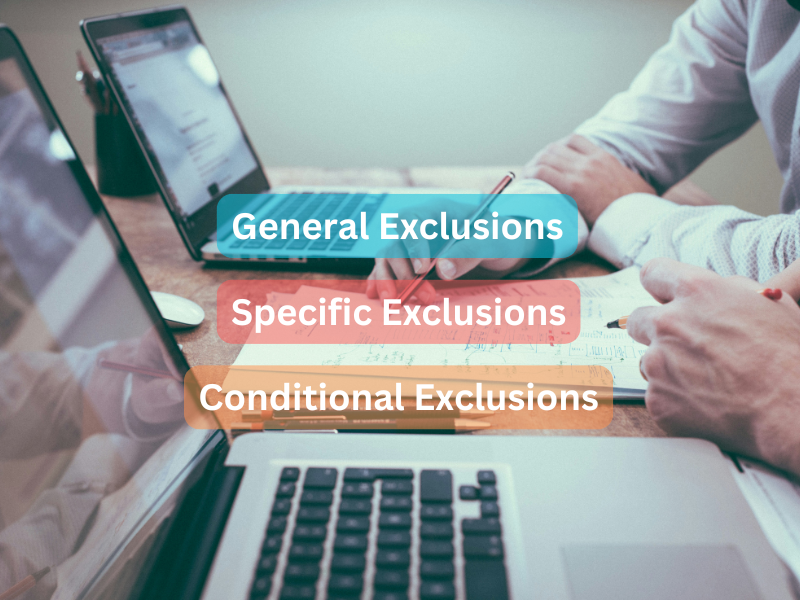Insurance serves as a critical safety net for individuals and businesses, offering financial protection against various risks. However, navigating the complexities of insurance policies can be challenging, especially when it comes to understanding the fine print.
One of the most significant aspects of insurance contracts is the concept of exclusions, which dictate what is not covered by the policy. Understanding exclusions is essential for policyholders, as they can significantly impact coverage and claims. This article will explore what are exclusions in insurance, their types, common examples, and their implications for policyholders.
What Are Exclusions in Insurance?
Exclusions in insurance refer to specific perils that are not covered by a policy. They are integral to the structure of insurance contracts, helping to define the scope of coverage. Essentially, exclusions limit the insurer’s liability by specifying risks that the policy will not cover. For instance, if a policy explicitly excludes damage from floods, the insurer is not obligated to compensate for losses resulting from a flood event.
The legal significance of exclusions cannot be overstated; they create a clear understanding between the insurer and the policyholder regarding what is and isn’t covered. Insurers use exclusions to protect themselves from claims that fall outside the intended coverage, allowing them to manage risk more effectively.
Types of Exclusions
Exclusions in insurance policies can generally be grouped into three main categories, each serving a different purpose in limiting the insurer’s liability. Understanding these types of exclusions can help policyholders better navigate their coverage options and assess the risks that are left uncovered.
General exclusions
General exclusions are broad, commonly applied restrictions found across most types of insurance policies. These exclusions typically target risks that are too unpredictable, unmanageable, or catastrophic for insurers to cover. By excluding certain large-scale events or high-risk behaviors, insurers can maintain stability and keep premiums affordable.
For example, most insurance policies exclude coverage for acts of war or nuclear accidents, as the potential damage from such events would be nearly impossible to calculate or financially cover. Similarly, intentional damage caused by the policyholder is another standard general exclusion. If a person deliberately causes harm to their property or themselves, insurance providers will not compensate for such actions.
Specific exclusions
Specific exclusions are tailored to particular risks or events that may not be covered under a given insurance policy. These exclusions vary depending on the type of insurance and the insurer, and they are often more detailed than general exclusions. Insurers use specific exclusions to limit their exposure to high-risk or costly events that do not fit within the policy’s core coverage.
For instance, a homeowners’ insurance policy might exclude coverage for damages caused by certain natural disasters, such as earthquakes or floods. In such cases, homeowners may need to purchase separate policies or additional riders to cover these risks. This is often seen in named perils coverage, which only covers risks specifically listed in the policy, unlike all risk coverage, which covers everything except what’s explicitly excluded.
Similarly, a life insurance policy may have specific exclusions related to high-risk activities like skydiving or scuba diving, where the insurer views the likelihood of a claim as significantly higher due to the inherent danger involved in these activities.
Conditional exclusions
Conditional exclusions apply only under specific conditions or circumstances, making them more flexible than broad general or specific exclusions. These exclusions activate when particular criteria are met, and they often require close attention from the policyholder to understand when and how they might apply.
For example, a health insurance policy may exclude coverage for treatment related to pre-existing conditions. In this scenario, if a policyholder seeks treatment for a medical condition that existed before they obtained the policy, the insurer may deny the claim under this exclusion. However, some policies may cover pre-existing conditions after a certain waiting period, so policyholders need to be aware of when coverage begins for those conditions.
These exclusions often depend on specific circumstances, meaning the same policy could cover an event in one case but exclude it in another depending on the surrounding conditions.

Common Examples of Exclusions
Understanding common exclusions can help policyholders make informed decisions about their insurance needs. Some common examples of exclusions are the following:
- Natural disasters – Many insurance policies exclude coverage for damages resulting from natural disasters like floods, earthquakes, and hurricanes. Businesses often need to purchase umbrella insurance to protect against these risks.
- Pre-existing conditions – Health insurance policies often contain exclusions for pre-existing conditions. This means that if an individual has a medical condition prior to purchasing the policy, related treatments may not be covered.
- Negligence or misconduct – Exclusions may also apply in cases of negligence or intentional misconduct. For instance, if a policyholder causes an accident while driving under the influence of alcohol, the insurer may deny coverage for damages resulting from that incident.
Why Exclusions Exist
Exclusions serve several purposes in the insurance industry. They primarily help insurers manage risk and control their liability. By clearly defining what is not covered, insurers can set appropriate premium rates and limit potential losses. This risk management approach ensures that insurance remains affordable for the majority of policyholders. Without exclusions, insurers would face too much uncertainty, making it harder to price policies fairly. This could lead to much higher premiums for everyone.
Moreover, exclusions can help policyholders understand the limitations of their coverage, prompting them to seek additional coverage when necessary. By being aware of exclusions, policyholders can avoid unpleasant surprises when filing claims. This understanding allows them to take a proactive approach to managing uncovered risks, either by adjusting their policies or setting aside resources for those gaps.
Implications of Exclusions for Policyholders
Failing to understand exclusions can have significant consequences for policyholders. If a claim is made for an event or situation that falls under an exclusion, the insurer is likely to deny the claim, leaving the policyholder without financial support during a critical time.
Additionally, reviewing exclusions during the policy selection process is vital. Policyholders should ask questions and seek clarification about any exclusions they may not understand. This proactive approach can help them tailor their coverage to their specific needs and avoid coverage gaps.
Understanding exclusions can also influence the decision-making process regarding insurance needs. If a policyholder is aware of potential exclusions that could affect them, they might consider additional coverage options to mitigate risks.

Conclusion
Now that you know what are exclusions in insurance, you understand that they are a key part of insurance policies that form the extent of coverage. Also, you know how exclusions influence the financial protection policyholders receive. Understanding the different types of exclusions, as well as their specific examples and effects, enables policyholders to make better decisions about their coverage.
Carefully reviewing policy details and seeking clarification when needed ensures there are no surprises when filing claims. Regularly assessing and updating coverage can also help maintain adequate protection. In the end, being well-informed about exclusions allows policyholders to better manage their insurance and mitigate risks effectively.
